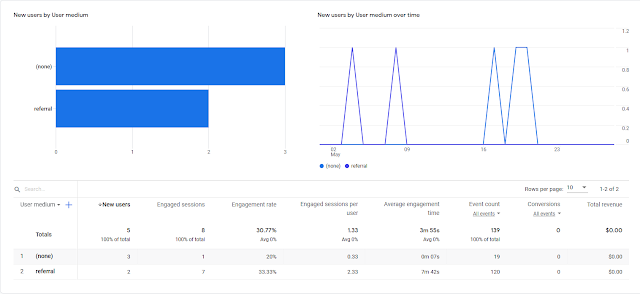Week 14 Part A: What we Learn from Google Analytics
Google Analytics
Acquisition
- Direct: Your customer typed in your URL or clicked on a bookmark.
- Organic search: This is a result from a search engine.
- Paid search: Like above but you paid a search engine to drive the results.
- Social networks: Facebook, Twitter, Instagram, etc
- Email campaigns
- Referral: Any websites that link to yours.
- Other advertising
Engagement
Engagement measures any user interaction with your site or app such as scrolling, filling out a form or buying a product.
 |
| Screen capture of engagement from my Blogger site |
Demographics
The demographics category includes four dimensions, all which Google aligns with the ones they use in Google Adwords. Having the statistics of your visitors gives you gives you key information about your target market. You can then use that information to run a Google Adwords campaign targeting the same audience
- Age Group: the user will be assigned to one of six age groups (18–24, 25–34, 35–44, 45–54, 55–64, 65+) based on their browsing behavior
- Gender: male or female
- Affinity Categories: predicted interests of the user based on their online behavior and purchases.
- In-Market Segments: predicted industry segment of the user (e.g. travel, education/post-secondary, etc.)
Why I feel these metrics are the most important.
Aid in SEO: The statistics supplied by Google Analytics can be useful for informing our SEO.
The platform helps to answer questions about how users find
us and interact with our site. It will tell us how much traffic our sit is getting, which pages perform the best, which search queries visitor use to find us, and what is the bounce rate.
Improve site performance: Currently Trident Pacific Consulting gets very little web traffic. Learning what engages the viewer will help to guide future revisions of the website. It can help us determine which pages get the most traffic, how long the visitors spend on each page, and at what stage a visitor leaves the site. Revisions can be made to get more conversions.
Improve marketing campaigns: Gathering a broad range of data about current visitors will help target future viewers. Most importantly the data can aid us to focus our efforts on the channels that bring the most visitors, especially the ones that are legitimately looking for services in our niche and convert to real paying clients.
Project Activity: I liked and commented on all of my classmates Business Facebook pages when we were asked to do so early in the semester.



Comments
Post a Comment